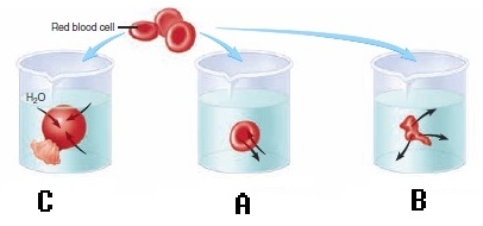A) amino acids in a protein.
B) nucleotides in the anticodons of tRNA.
C) nucleotides in a gene.
D) amino acids in DNA.
E) codons in DNA.
G) B) and C)
Correct Answer

verified
Correct Answer
verified
Multiple Choice
Which of the following sequences is correct?
A) translation transcription protein synthesis
B) transcription protein synthesis translation
C) translation protein synthesis transcription
D) transcription translation protein synthesis
E) protein synthesis translation transcription
G) B) and E)
Correct Answer

verified
Correct Answer
verified
Multiple Choice
At the base of each cilium is a structure called the
A) kinetochore.
B) basal body.
C) dynein arm.
D) centrosome.
E) None of these choices is correct.
G) A) and B)
Correct Answer

verified
Correct Answer
verified
Multiple Choice
The aroma of cookies baking in the kitchen reaches you in the living room.The distribution of this odor throughout the house is an example of
A) osmosis.
B) filtration.
C) diffusion.
D) dialysis.
E) active transport.
G) A) and B)
Correct Answer

verified
Correct Answer
verified
Multiple Choice
 -Red blood cells (RBCs) have been placed in three different solutions: hypotonic,hypertonic,isotonic.What is solution "B" relative to the RBC?
-Red blood cells (RBCs) have been placed in three different solutions: hypotonic,hypertonic,isotonic.What is solution "B" relative to the RBC?
A) hemolyzed
B) isotonic solution
C) hypertonic solution
D) crenated
E) hypotonic solution
G) B) and E)
Correct Answer

verified
Correct Answer
verified
Multiple Choice
A cell uses centrioles in the process of
A) protein synthesis.
B) RNA replication.
C) cell division.
D) energy generation.
E) nuclear centering.
G) A) and D)
Correct Answer

verified
Correct Answer
verified
Multiple Choice
Which of the following is NOT a G-protein complex protein?
A) delta
B) gamma
C) alpha
D) beta
E) None of these choices are correct.
G) B) and D)
Correct Answer

verified
Correct Answer
verified
Multiple Choice
The sodium-potassium pump located in the plasma membrane
A) osmotically moves sodium into cells.
B) actively transports potassium into cells.
C) actively transports water out of cells.
D) moves chlorine out of cells.
E) actively transports sodium into cells.
G) C) and D)
Correct Answer

verified
Correct Answer
verified
Multiple Choice
Which of the following cell organelles does not contain microtubules?
A) cilia
B) flagella
C) spindle fibers
D) centrioles
E) All of these choices contain microtubules.
G) B) and D)
Correct Answer

verified
Correct Answer
verified
Multiple Choice
The environment outside the plasma membrane is most appropriately referred to as
A) intracellular.
B) extracellular.
C) multicellular.
D) centrocellular.
E) None of these choices are correct.
G) C) and E)
Correct Answer

verified
Correct Answer
verified
Multiple Choice
Which of the following pairs of terms is mismatched?
A) lysosomes - hydrolytic enzymes
B) mitochondria - cristae
C) Golgi apparatus - cisternae
D) cilia - basal bodies
E) smooth endoplasmic reticulum - chromatin
G) A) and B)
Correct Answer

verified
Correct Answer
verified
Multiple Choice
In ______________,carrier molecules move a substance against (up) the concentration gradient.
A) facilitated diffusion
B) simple diffusion
C) endocytosis
D) active transport
E) exocytosis
G) A) and E)
Correct Answer

verified
Correct Answer
verified
Multiple Choice
Plasma membrane phospholipids
A) have nonpolar fatty acid tails.
B) form a bilayer.
C) have polar phosphate heads.
D) create a selectively permeable barrier.
E) All of these choices are correct.
G) D) and E)
Correct Answer

verified
Correct Answer
verified
Multiple Choice
Arrange the following events of exocytosis in the correct sequence: (1) vesicle membrane fuses with plasma membrane (2) secretory vesicles migrate to plasma membrane (3) vesicle contents are expelled from cell (4) secretions accumulate within secretory vesicles
A) 1,4,2,3
B) 2,1,4,3
C) 1,2,3,4
D) 4,2,1,3
E) 3,1,4,2
G) A) and B)
Correct Answer

verified
Correct Answer
verified
Multiple Choice
According to the most current model of the plasma membrane,
A) the membrane is a rigid unchanging structure.
B) cholesterol forms the innermost layer of the membrane.
C) phospholipids and cholesterol form a single lipid bilayer.
D) proteins are free to move about within a double layer of phospholipids.
E) the membrane is impermeable to all other molecules.
G) A) and B)
Correct Answer

verified
Correct Answer
verified
Multiple Choice
What type of membrane proteins form a passageway through the plasma membrane?
A) carrier proteins
B) receptor proteins
C) enzymes
D) channel protein
E) marker molecules
G) B) and C)
Correct Answer

verified
Correct Answer
verified
Multiple Choice
A cell's ability to replenish ATP is reduced by a metabolic poison.Which organelle is being affected?
A) nucleus
B) mitochondrion
C) centriole
D) ribosomes
E) microtubule
G) None of the above
Correct Answer

verified
Correct Answer
verified
Multiple Choice
The process by which there is programmed cellular death is _____.
A) apoptosis
B) differentiation
C) mitosis
D) cleavage
F) None of the above
Correct Answer

verified
Correct Answer
verified
Multiple Choice
Pinocytosis
A) forms vesicles only when large amounts of material are being transported.
B) does not require ATP.
C) is a form of exocytosis.
D) involves ingestion of liquids rather than particles.
E) does not require the formation of vesicles.
G) A) and B)
Correct Answer

verified
Correct Answer
verified
Multiple Choice
Which of the following is NOT an example of a cytoplasmic inclusion?
A) lipid droplets
B) hemoglobin
C) actin filaments
D) melanin
E) lipochrome
G) B) and C)
Correct Answer

verified
Correct Answer
verified
Showing 21 - 40 of 228
Related Exams